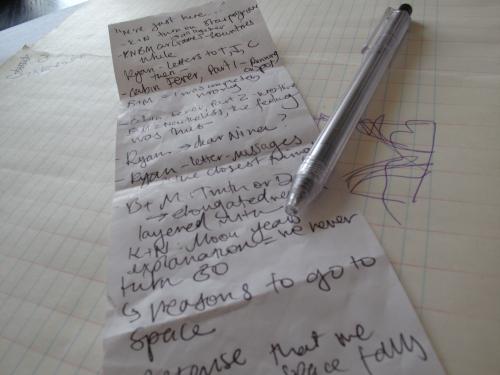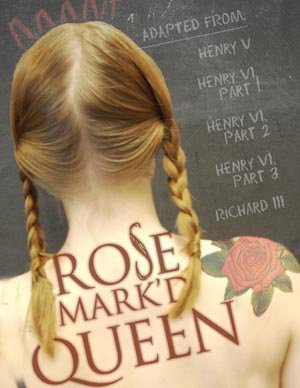Thursday night the Yale Cabaret will open its doors for its new season. Regulars will find, even before they get through the doors into the performance space, that the aura of the Cab has changed once again. The box office and waiting area now feels like a somewhat seedy, somewhat creepy hotel (it immediately put me in mind of the McKittrick Hotel from Sleep No More), a fitting enough indication that what’s on offer through the doors will surprise, delight, and discomfit.

Since its inception in 1968, the Yale Cabaret has been a special space for students in the Yale School of Drama: it’s where they can work on what motivates them, things they might not be able to do in the work that satisfies grad school requirements, but thanks to the resources of the school the Cab’s theater artists can work out ideas in conjunction with a large, supportive network of colleagues representing all the disciplines of theater. As the Cab’s new website states: “Nowhere else in the world are there more than 200 theater artists living in a four-block radius – the possibilities are endless.” Indeed they are, given the extreme restrictions of the space itself and the fact that the budget for every show is about $300 and that, incredibly, shows go up and play for a total of five performances before changing over to the next feature. It’s a frenetic pace, but once you get “the Cab Habit” you’ll be back each weekend to see what’s on offer.
This year the leadership of the Cab, in something of a departure from recent years, will feature, like some of the best shows that have been presented there, an ensemble: four Artistic Directors: three third years—Lileana Blain-Cruz (director), Sunder Ganglani (dramaturg), Michael Place (actor)—and a second year, Kate Attwell (dramaturg); they are joined by theater manager Matt Gutshick to create a team that is fully interdisciplinary within the world of theater. When I spoke to them this week they had yet to vet the proposals for the shows that will fill out the season, but if there’s any underlying theme, it’s the belief that a theater like the Cab exists to promote experiment, the kind that involves risk and vulnerability, not only for the company and the technical support, but for the audience as well.
All four of the artistic directors are united in their view that theater’s importance as art, and its primary attraction as entertainment, is due to the unpredicable interaction that takes place between audience and spectacle. What makes one person guffaw makes someone else sad or uneasy. The proximity of audience to event is a factor that informs each piece—there’s nowhere to hide from a Cab show, for the audience. And for the performers, the audience can’t be ignored either. The audience completes the work, and the viewers’ individual and collective reactions help reveal what the work means.
 The first show of the new season looks directly at the interactive dynamic of performers and audience. Entitled Slaves, it’s a musical piece for three actors—actors who, for the duration of the performance, are enslaved to one another, and to the music, and to the audience. The piece, according to Sunder Ganglani, who wrote the book and primary music, explores the theatrical experience as an imposition upon the performers who must in some way take upon themselves emotions and ideas not their own and find a way to express them to an audience. Slaves uses musical cues to switch gears and to bring on certain behaviors, but does that make the work the master of the cast? Or, because it’s for us, does that make the audience the master? Or is it rather theater that masters us all, enslaved to the interaction between our imaginations and a performance? With three risk-taking performers like Chris Henry, Jillian Taylor and Adina Verson in the cast, the show should be memorable. Sept. 15th, 8 p.m., Sept. 16th & 17th, 8 p.m. and 11 p.m.
The first show of the new season looks directly at the interactive dynamic of performers and audience. Entitled Slaves, it’s a musical piece for three actors—actors who, for the duration of the performance, are enslaved to one another, and to the music, and to the audience. The piece, according to Sunder Ganglani, who wrote the book and primary music, explores the theatrical experience as an imposition upon the performers who must in some way take upon themselves emotions and ideas not their own and find a way to express them to an audience. Slaves uses musical cues to switch gears and to bring on certain behaviors, but does that make the work the master of the cast? Or, because it’s for us, does that make the audience the master? Or is it rather theater that masters us all, enslaved to the interaction between our imaginations and a performance? With three risk-taking performers like Chris Henry, Jillian Taylor and Adina Verson in the cast, the show should be memorable. Sept. 15th, 8 p.m., Sept. 16th & 17th, 8 p.m. and 11 p.m.
 The following week, fellow Artistic Director Kate Attwell launches the hundredyearspacetrip, developed with Nina Segal, of We Buy Gold, and the ensemble. The show, which involves communication between the earth and a manned spacecraft hurtling 39,900,000,000,000 km to Alpha Centauri, is a meditation on time—as aging, as the lapse between one event and another, as passage from one age or state to another, as for instance pregnancy to childbirth, and of course youth to death on a journey to a star system far, far away. Attwell says the show is surprisingly funny because of the interactions among the characters, bringing to life a situation that is literally out of this world. Featuring Brenda Meaney and Ryan Davis. Sept. 22nd, 8 p.m., Sept. 23rd & 24th, 8 p.m. and 11 p.m.
The following week, fellow Artistic Director Kate Attwell launches the hundredyearspacetrip, developed with Nina Segal, of We Buy Gold, and the ensemble. The show, which involves communication between the earth and a manned spacecraft hurtling 39,900,000,000,000 km to Alpha Centauri, is a meditation on time—as aging, as the lapse between one event and another, as passage from one age or state to another, as for instance pregnancy to childbirth, and of course youth to death on a journey to a star system far, far away. Attwell says the show is surprisingly funny because of the interactions among the characters, bringing to life a situation that is literally out of this world. Featuring Brenda Meaney and Ryan Davis. Sept. 22nd, 8 p.m., Sept. 23rd & 24th, 8 p.m. and 11 p.m.
 The third in the initial run of shows will be a staging of Ingmar Bergman’s Persona, adapted and directed by Alexandru Mihail. With the death of Swedish master filmmaker Bergman a few years back, there have been several notable efforts to stage his films, most recently Robert Woodruff’s version of Autumn Sonata at the Yale Rep last spring, and Cries and Whispers will be coming to the Brooklyn Academy of Music this fall. Persona though is vintage Bergman, before he used color, and is a film limited primarily to two main characters: an actress who suddenly cannot perform and will not speak, and the nurse hired to attend her—on a secluded Scandinavian island.
The third in the initial run of shows will be a staging of Ingmar Bergman’s Persona, adapted and directed by Alexandru Mihail. With the death of Swedish master filmmaker Bergman a few years back, there have been several notable efforts to stage his films, most recently Robert Woodruff’s version of Autumn Sonata at the Yale Rep last spring, and Cries and Whispers will be coming to the Brooklyn Academy of Music this fall. Persona though is vintage Bergman, before he used color, and is a film limited primarily to two main characters: an actress who suddenly cannot perform and will not speak, and the nurse hired to attend her—on a secluded Scandinavian island.
The film is a high point in the major phase of Bergman’s career, when Liv Ullmann was his acting muse, and, more than the other films so far brought to the stage, incorporates the problem of performing as it relates to theater and to the theater of identity that is social life. Mihail has always found the film compelling but recently read the script—which was published after the film but which differs from the film in certain important ways. The point of the show, then, is not to recreate Bergman’s “European cinematic experience,” but to do with theater something not “already done” in film. With Laura Gragtmans, Monique Barbee, Lucas Dixon, Emily Reilly. Oct. 6th, 8 p.m., Oct 7th & 8th, 8 p.m. and 11 p.m.
Those are the shows lined up thus far, each provocative and thought-provoking in its own way, each a unique theatrical experience. The Artistic Directors of the Cab see the space as a laboratory where we’re all part of the experiment.
See you at the Labaret . . . the Caboratory. The Cab.
The Yale Cabaret
Artistic Directors: Kate Atwell, Lileana Blain-Cruz, Sunder Ganglani, Michael Place
Managing Director: Matthew Gutshick
217 Park Street, New Haven, CT: 202.432.1566; http://www.yalecabaret.org/







